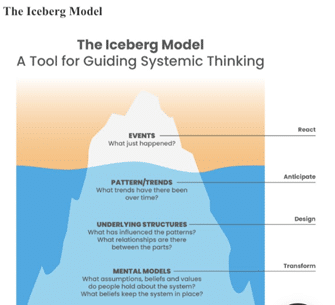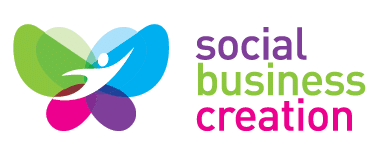SBC101 case
ANALYSIS OF THE IMPACTS OF VINASAMEX ON SOCIAL THROUGH ICE BERG MODEL
“Beyond the Surface: Using the Iceberg Model to Uncover the Systemic Impact of Vinasamex”
LE HOANG YEN NHI, Vu Thi Phuong Dung – VINASAMEX GROUP
30/04/2023
Brief Description
This case study explores the systemic impact of Vinasamex, a successful social enterprise in Vietnam that grows and processes cinnamon and star anise. The study uses the iceberg model as a tool for system thinking to analyze the impact of Vinasamex on various stakeholders, including farmers, employees, and the environment. The study also examines how Vinasamex has achieved gender equality and social inclusion in its operations, and how it has expanded its market reach through quality improvement and innovation. The case study highlights the importance of using a systemic approach to understand the social and economic impact of a social enterprise like Vinasamex, and the potential for such enterprises to create positive change in communities and societies.
Introduction
Lisa Huyen, the CEO of Vinasamex, a leading enterprise in Vietnam, spoke about the company’s journey in promoting the use of cinnamon, star anise, and other organic spices globally. In 2012, the company was established to export cinnamon and star anise to countries such as India and Bangladesh. The company expanded to direct exports to the EU, the United States, Japan, and Korea. Vinasamex trained farmers to cultivate cinnamon and star anise with organic processes. The company also promised to purchase products at a higher price if the farmers obeyed organic farming principles. Vinasamex has been working on organic cinnamon and star anise cultivation across 4,200 hectares with more than 3,000 farming households in Yen Bai, Lao Cai, and Lang Son provinces.
To preserve biodiversity, Vinasamex works on solutions to challenges such as encroachment on natural forests, deforestation for cultivation use, chemical fertilizers and pesticides, hunting wild animals, invasive species, and waste from daily-life and production activities. The company does regular training for workers and has 120 team leaders that monitor and communicate the practices that they promote.
The company is also dedicated to supporting and improving the livelihoods of poor local communities in rural areas of Yen Bai and Lang Son provinces, Vietnam. Shifting the business strategy of exporting cinnamon, star anise, and spices from the mid- and low-end markets to high-end markets, which requires higher quality, has created development for Vinasamex and elevated the position of Vietnamese cinnamon and star anise in international markets.
Vinasamex has created jobs for hundreds of formal workers and thousands of seasonal workers. Farmers in the company’s value chain of organic cinnamon and star anise remain committed because the company pays at least 10% higher than the market price, contributing to a more stable income for people. The company contributes to local projects such as supporting local education, housing, and infrastructure, and helps 1,200 women access financial resources independently.
Initially, Vinasamex faced difficulty as a young businesswoman to impose innovative views on farmers used to traditional methods. Despite opposition, Huyen was determined to improve the value of cinnamon with a firm belief that “If I do well at the root of things, these new values will be sustainable.” After two years, many farmers signed up to follow the company’s processes after they saw a clear increase in income.
Overview of Iceberg Model

The iceberg model is a tool for analyzing complex systems and understanding the underlying factors that influence their behavior. In the case of Vinasamex, the iceberg model provides a useful framework for exploring the systemic impact of the enterprise on various stakeholders, including farmers, employees, and the environment.
At the surface level, Vinasamex is a successful business that generates revenue and creates jobs. However, digging deeper into the iceberg model reveals a more nuanced picture of the enterprise and its impact on the community. For example, Vinasamex has implemented a range of gender equality and social inclusion initiatives in its operations, including hiring a significant number of female employees and offering training and education programs to help women develop skills and advance in their careers. These initiatives have had a positive impact on the lives of female employees and their families, and have helped to promote gender equality in the community.
Looking further down the iceberg, Vinasamex’s impact on the environment is an important factor to consider. The enterprise uses sustainable farming practices, such as crop rotation and natural pest control, to minimize the use of pesticides and fertilizers. This approach helps to protect the soil and water resources, and ensures the long-term viability of the farming land. Additionally, Vinasamex has implemented a waste management program to reduce the amount of waste generated by its operations and promote recycling and reuse.
At the deepest level of the iceberg, Vinasamex’s impact on the community and society as a whole is an important factor to consider. By providing jobs and economic opportunities to farmers and employees, Vinasamex has contributed to the overall economic development of the region. The enterprise also supports local schools and community projects, and has established partnerships with local NGOs to promote sustainable development in the community. These initiatives have helped to create a positive impact on the broader community, and demonstrate the potential for social enterprises like Vinasamex to drive positive change at a systemic level.
Overall, the iceberg model provides a valuable tool for analyzing the impact of Vinasamex on various stakeholders and understanding the complex interactions between the enterprise and the broader community. By considering the surface, middle, and deep levels of the iceberg, we can gain a more comprehensive understanding of the enterprise’s impact and potential for creating positive change in the world.
Based on the iceberg analysis, the following leverage points for change could be considered to address the underlying causes of the problem:
- 1. Education and Awareness: Increasing education and awareness about the harmful effects of conventional farming practices and the benefits of sustainable and organic farming practices could be a powerful leverage point for change. This could include educating farmers, local communities, and consumers about the impacts of chemical pesticides and fertilizers on the environment and human health, as well as the benefits of using organic and compost in cultivation.
- Regulatory and Policy Changes: Encouraging or advocating for regulatory and policy changes that support sustainable and organic farming practices could be an important leverage point. This could include advocating for stricter regulations on the use of harmful chemicals and GMO varieties, as well as providing incentives and support for farmers who adopt sustainable practices.
- Access to Resources: Providing farmers with the resources they need to adopt sustainable and organic farming practices could be a crucial leverage point. This could include providing training, tools, and equipment for sustainable cultivation of productive forest land, as well as support for waste management and composting.
- Economic Incentives: Creating economic incentives for farmers to adopt sustainable and organic farming practices could be a powerful leverage point. This could include providing fair prices for organic products, as well as supporting local markets and promoting the economic benefits of sustainable practices.
- Partnership and Collaboration: Developing partnerships and collaborations with local communities, NGOs, and other stakeholders could be an effective leverage point for promoting sustainable and organic farming practices. This could include working with local communities to develop sustainable forestry management plans and promote biodiversity conservation, as well as partnering with NGOs to provide training and support for sustainable farming practices.
Results
Vinasamex has used systems thinking to address the problem of unsustainable and harmful farming practices and create sustainable social impact. By recognizing that the problem is complex and interconnected, Vinasamex has taken a holistic approach to address the underlying causes of the problem and create lasting change.
One example of Vinasamex’s systems thinking approach is their focus on education and awareness. They recognize that education and awareness are key leverage points for change and have implemented various initiatives to increase knowledge and understanding of sustainable farming practices. This includes providing direct information to farmers about laws and regulations, training them on the importance of biodiversity and clean water, and promoting the benefits of sustainable cultivation practices to consumers. As a result, exported cinnamon worths 5000 – 7000$ per tons while in the past, it only worths 2000$ per tons. The Vinasamex’s cinnamon factory in Yen Bai takes place in a 11000 m2 area, where more than 100 employees is diligently working. Everyday, 40 tons of fresh cinnamon are bought with a guarantee price that are 10% higher than the market price, resulting in exporting 400 tons of cinnamon per month.
Vinasamex has also worked to address the economic incentives for farmers to adopt sustainable practices. Vinasamex provided training and resources to at least 468 farming households on how to make and use herbal pesticides well and thoroughly apply the principles of integrated pest management. In 2013, Vinasamex started building a value chain with farmers. The company no longer buys through traders, but works with individual farmers to create a value chain, called hobby farmer groups. Currently, there are about 1400 households cooperating with Vinasamex. The company trains and guides farmers to grow cinnamon and star anise using organic methods, applying modern science and technology to the processing of high-quality raw materials and anise essential oil. To this day, 2 courses have been held to train these local farmers. By doing so, Vinasamex were able to equip farmers with the knowledge and resources they needed to implement sustainable farming practices.
They have provided fair prices for organic products, supported local markets, and promoted the economic benefits of sustainable practices. Additionally, they have partnered with local communities and NGOs to provide resources and training for sustainable cultivation practices, and have advocated for regulatory and policy changes that support sustainable and organic farming.
By taking a systems thinking approach, Vinasamex has been able to create sustainable social impact by addressing the underlying causes of the problem and creating lasting change. They have recognized the interconnectedness of various factors that contribute to the problem and have worked to address them in a holistic manner, rather than simply treating the surface-level symptoms. This approach has allowed Vinasamex to create meaningful change that benefits farmers, local communities, and the environment in the long term.
Conclusion
In conclusion, the case study of Vinasamex demonstrates the potential for social enterprises to create positive change in communities and societies. By using a systemic approach to analyze the impact of Vinasamex, we have gained insight into the complex relationships and interactions that contribute to the success of the enterprise. The study highlights the importance of considering the systemic impact of social enterprises, and the potential for these enterprises to address social and environmental issues while also achieving economic success.
References
CEO Vinasamex Nguyễn Thị Huyền: Nếu đã có đích đến thì cần gì phải vội! (2023, January 29). BSC. Retrieved April 29, 2023, from https://www.bsc.com.vn/tin-tuc/tin-chi-tiet/989738-ceo-vinasamex-nguyen-thi-huyen-neu-da-co-dich-den-thi-can-gi-phai-voi
Home. (n.d.). YouTube. Retrieved April 29, 2023, from https://www.nguoiduatin.vn/e-nguoi-nong-dan-viet-dang-khoac-tren-minh-chiec-ao-moi-a589322.html
Huyen, L. (n.d.). Creating social impact in Vietnam. PUM. Retrieved April 29, 2023, from https://www.pum.nl/en/what-we-do/stories/creating-social-impact-vietnam
Linh, Q., & Linh, L. (2022, April 8). Vinasamex JSC offers 15% shares worth VND 135 billion. Vietnam Agriculture. Retrieved April 29, 2023, from https://vietnamagriculture.nongnghiep.vn/vinasamex-jsc-offers-15-shares-worth-vnd-135-billion-d320127.html
“Mỏ vàng” từ nhiều loại cây gia vị quý đang bị lãng phí. (2023, March 22). Hiệp hội Hồ tiêu Việt Nam. Retrieved April 29, 2023, from https://peppervietnam.com/mo-vang-tu-nhieu-loai-cay-gia-vi-quy-dang-bi-lang-phi/
Perseverance, hard work key to success: Vinasamex CEO. (2023, February 3). Theinvestor. Retrieved April 29, 2023, from https://theinvestor.vn/perseverance-hard-work-key-to-success-vinasamex-ceo-d3515.html
Phát triển bền vững cây quế. (2022, June 28). Báo Yên Bái. Retrieved April 29, 2023, from http://baoyenbai.com.vn/12/246146/Phat-trien-ben-vung-cay-que.aspx
Social responsibility – Vinasamex. (n.d.). Vinasamex. Retrieved April 29, 2023, from https://vinasamex.com/social-responsibility/
Thận trọng khi trồng quế tự phát. (2022, August 30). Báo Nhân dân. Retrieved April 29, 2023, from https://nhandan.vn/than-trong-khi-trong-que-tu-phat-post712830.html
Thận trọng mở rộng vùng trồng, kiểm soát chặt chất lượng quế. (2022, October 17). Nông sản Việt. Retrieved April 29, 2023, from https://nongsanviet.nongnghiep.vn/than-trong-mo-rong-vung-trong-kiem-soat-chat-chat-luong-que-d334931.html
Vẫn còn nhiều thách thức đối với sự phát triển của ngành quế Việt Nam. (2022, November 4). Báo điện tử – Đảng Cộng sản Việt Nam. Retrieved April 29, 2023, from https://dangcongsan.vn/kinh-te/van-con-nhieu-thach-thuc-doi-voi-su-phat-trien-cua-nganh-que-viet-nam-623613.html
VinaSamex | iBAN. (n.d.). Inclusive Business Action Network. Retrieved April 29, 2023, from https://www.inclusivebusiness.net/IB-Universe/ib-companies/vinasamex
VinaSamex – Inclusive Impact Investments. (n.d.). Inclusive Impact Investments. Retrieved April 29, 2023, from https://www.inclusive-investments.com/vinasamex/

